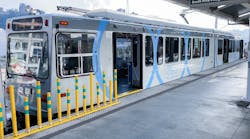Apr. 2—In the coming weeks and months, many riders of Pittsburgh Regional Transit's light rail system will need to prepare for changes in how they get around the South Hills and Downtown Pittsburgh.
On Tuesday during a virtual presentation and town hall, PRT officials detailed multiple projects either getting underway or that will start in upcoming years that will be focused on updating much of the 26.2-mile light rail system that connects Pittsburgh's North Shore to its South Hill neighborhoods and suburbs. The total cost is more than $150 million, they estimate.
Some of the work that is scheduled to begin later this week involves plinth repairs for stations in Downtown Pittsburgh. In the Downtown stations, plinths are the concrete beams upon which the tracks rest. Officials said work between April 5 and May 31 will occur seven days a week, and Wood Street Station will be closed. Light rail trains from the South Hills will be detoured from Steel Plaza to Penn Station, where riders can get a free shuttle to the Gateway station. Trains from Allegheny will serve the Gateway and North Shore stations.
Officials noted, however, that the free shuttles will not run during major events like the Pittsburgh Marathon, BikePGH's Open Streets, or for the Rush to Crush Cancer.
The work is estimated to cost $35 million, and PRT officials are planning for intermittent closures during weekends in the fall. There also will be several weeks of closures in January and February, and tentative weekend closures in the spring of 2025.
One attendee asked why the shuttle bus wouldn't run from Penn Station to Allegheny Station, the northern terminus of the light rail lines. Amy Silbermann, chief development officer for PRT, said the shortage of bus drivers, along with the increased activity in the North Shore for concerts, Pirates games and other events, were reasons for the current route.
Another major project that will occur, beginning in late 2025 and running into 2028, is the replacement of tracks and overhead power lines on the Panhandle Bridge, which carries the light rail trains across the Monongahela River. The bridge will also be rehabbed and painted, and officials estimate the project will cost $67.5 million. Trains will be single-tracked across the bridge, with intermittent closures. No delays are expected on inbound trains to Downtown, but up to three-minute delays could be possible outbound.
PRT officials also are planning to replace 10,000 feet of light rail tracks, beginning in May. The work will cause multiple station closures along the Red Line in the South Hills, and shuttle bus service will be provided, they said. A light rail shuttle will also operate between Overbrook Junction and Dormont Junction to connect to the bus shuttles, officials said. They plan for the work to be finished by the end of August, and cost estimates for work along the Red Line are about $20 million.
Officials are also planning an eight-month closure in 2025 of the light rail inside the Mount Washington Transit Tunnel in order to replace the rail tracks in that stretch. Trains that use the tunnel will be rerouted along the Allentown line along East Warrington and Arlington avenues, which will result in a five- to eight-minute delay in those trips, officials said.
Greg O'Hare, chief engineer for PRT, said cost estimates for that project are preliminary but currently stand at $20 million to $25 million.
Mr. O'Hare said the major rehab work — including on the Downtown plinths, the Panhandle Bridge, at various points along the Red Line, and Mount Washington Transit Tunnel — will be the first time such activity has occurred in about four decades.
The Panhandle Bridge was converted from a heavy freight bridge to light rail around that time, and PRT officials also started to install much of the light rail infrastructure that we see today, he said.
"All of this rail work that we're going through, replacing ... this rail was installed as part of what we call 'Phase One' in the early 1980s when PRT, formerly [the] Port Authority, had embarked on [creating] a new light rail system from the old trolley system," Mr. O'Hare said.
___
(c)2024 the Pittsburgh Post-Gazette
Visit the Pittsburgh Post-Gazette at www.post-gazette.com
Distributed by Tribune Content Agency, LLC.



